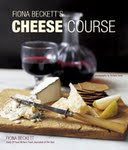It's been a quietish time on the cheese front while I've been planning my visit next month to the cheese emporia of New York but last week I made two discoveries: a new (to me) Irish cheese called St Gall and an impressively cheese-studded menu at St John Bread & Wine.
St Gall, which is being sold by one of Bristol's best cheese shops Trethowan's Dairy, is an Alpine-style unpasteurized cow's cheese a bit like Beaufort in taste with an incredibly intense almost fruity flavour. Neal's Yard compares it to an Appenzeller but again it has more flavour than any Appenzeller I've tasted. It's made by Frank and Gudrun Shinnick in Fermoy in Co Cork. Food writer Rose Prince describes it as 'the best cheese yet to come out of Ireland' which doesn't strike me as hyperbole.
It also sounds as if it would be fantastic to cook with judging by this recipe for parsnip, potato and St Gall cheese gratin from Richard Corrigan on the BBC website.
And all credit to St John Bread and Wine for featuring artisanal cheeses to the extent they do in their Spitalfields restaurant. When I passed the other day they had at least five cheese dishes including celery and Strathmore, Stinking Bishop and potatoes and Eccles cakes and Lancashire cheese and four individual cheeses. And at the parent restaurant St John you can have Welsh rarebit as a side order.
Thursday, November 26, 2009
Sunday, November 8, 2009
Pecorino Toscano
 I’ve spent the last couple of days at an organic estate in Tuscany which produces almost all its own food - olive oil, flour, bread, cheese, vegetables and, of course, wine. The cheese, a sheeps' cheese called Pecorino is the most common type produced in Tuscany and comes from milk produced from the sheep who graze the estate.
I’ve spent the last couple of days at an organic estate in Tuscany which produces almost all its own food - olive oil, flour, bread, cheese, vegetables and, of course, wine. The cheese, a sheeps' cheese called Pecorino is the most common type produced in Tuscany and comes from milk produced from the sheep who graze the estate. They have two main types - pecorino fresco, the young cheese which is served with antipasti such as bruschetti and salumi (cold meats) and a more mature one which is aged for 6-9 months and grated like parmesan (which is not made in Tuscany). Both are unpasteurized - the cheeses are subjected to heat treatment but it doesn’t go above 60°C. It’s milder than a parmesan which makes it a good companion for the local Chianti (and for other red wines - a useful attribute). The Tuscans also eat it with honey for breakfast or at the end of a meal.
The whey that is drained off the cheese is made into ricotta. Traditionally that would be eaten very fresh - it only has a shelf-life of 3 days but the LoFranco family who own the estate have found a way to preserve it in various spreads and spoonable desserts like a strawberry and ricotta mousse and ‘briachella’ a tiramisu-like mixture of ricotta, cantucci (traditional hard dipping biscuits) and their own vin santo (the famous Tuscan sweet wine).
Unfortunately I couldn’t see it any of the cheeses being made in the Caseificio (dairy) because the ewes are lambing at this time of year but they normally make them from December to July. You can buy the cheeses - and other products - direct by ordering a catalogue from the website.
Wednesday, November 4, 2009
Cheesy treats at Flinty Red
 Last night we went to a new restaurant and wine bar in Bristol called Flinty Red with a fashionable tapas-y sort of menu. Nothing unusual about that you might think except for the larger than usual number of dishes that were based on cheese. In fact I was so overjoyed by this I tried three of them as my starter, main course and dessert.
Last night we went to a new restaurant and wine bar in Bristol called Flinty Red with a fashionable tapas-y sort of menu. Nothing unusual about that you might think except for the larger than usual number of dishes that were based on cheese. In fact I was so overjoyed by this I tried three of them as my starter, main course and dessert.The first dish was Fontina cheese, toast, speck and Finocchiona (above). In my excitement I zoomed in on the words fontina cheese and toast and assumed it would involve melted cheese but in fact it was a plate of charcuterie and cheese with a toasted piece of sourdough alongisde. Couldn’t fault it though.
Next up - and my favourite dish - was buckwheat and Tallegio ravioli with chard and potato which was a star combination. (Potato and cheese - who could improve on that?)

And finally Perroche crushed with armagnac and Castagnaccio (below - an Italian chestnut flour cake) which I have to admit didn’t quite hit the spot. Perroche is a delicate cheese and lost its character under the assault of the armagnac. The chef, Matt said what he had really been after and had been unable to source had been goats’ curd which I think would have worked. (An accompanying glass of Bramley and Gage quince liqueur was spot on though).

Despite this reservation this is a great little restaurant with a fantastic wine, beer and drinks list and plenty for all foodlovers - not just cheeselovers - to enjoy.
Subscribe to:
Posts (Atom)

